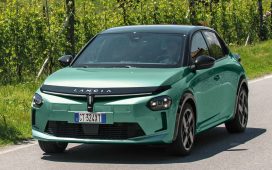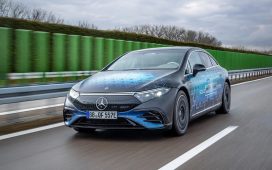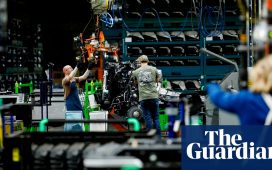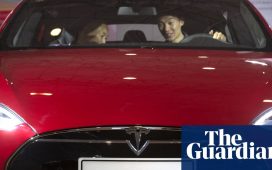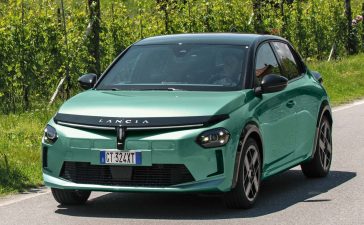Tools Equip Stakeholders To Better Understand Travel Habits, Data, and Energy Consumption
To Inform Transportation and Mobility Technology Advancements

fleet simulated with NREL’s Highly Integrated Vehicle System (HIVE) platform. Photo by Dennis Schroeder, NREL
Energy efficiency and on-road performance are central to the future of transportation
and the clean energy transition. The U.S. Department of Energy National Renewable
Energy Laboratory’s (NREL’s) modeling and analysis tools target technical barriers
to the advancement of technologies and systems that optimize efficiency and performance
while reducing emissions.
For decades, NREL has powered the development of numerous open-source tools to benefit
transportation decision makers, organizations, communities, and individuals. Unlike
software that uses proprietary and closely guarded code, open-source software is made
available for anyone to use, examine, alter, and redistribute at no cost. Because
this type of software is so customizable, it allows users to gear tools to meet their
unique needs and to answer their specific questions. Open-source software also levels
the playing field and provides a common framework for automakers, regulators, and
other research entities to share and validate each other’s work.
“Tools are only as useful as they are adaptable to specific needs, so it’s vital that
NREL’s transportation and mobility tools can address the specific challenges decision
makers face,” said NREL’s Jake Holden, a senior decarbonized vehicle systems researcher. “Open-source availability of these
transportation tools allows users to explore and customize scenarios as they consider
how to implement energy efficiency advancements into their processes. This could apply
to everything from route optimization to measuring personal carbon footprints by travel
mode, from mobility service operations’ impact on energy use to simulating and optimizing
cost-effective locomotive technologies.”
Simulating Technology Impacts on Transportation Decarbonization Outcomes
NREL developed various open-source transportation tools to tackle key aspects of travel
to support the development and efficient use of advanced transportation technologies
and systems.
Simulation and modeling software helps railway operators model the integration of
technologies to encourage transportation decarbonization and move toward a net-zero
carbon economy. The Advanced Locomotive Technology and Rail Infrastructure Optimization System (ALTRIOS) is one such software—an open-source simulation tool for guiding railway decarbonization.
ALTRIOS simulates real-world railway network operations to answer big questions around freight demand, speed, and train dynamics. It can
also shed light on the ideal powertrain technologies to use in various applications,
operating conditions, power distribution scenarios, and in fueling and charging infrastructure.
“Mode shifting freight to rail and decarbonizing rail is key to transitioning the
transportation sector to be carbon neutral,” said Chad Baker, NREL mechanical engineer.
“By better understanding how new locomotive technologies may impact and accelerate
decarbonization efforts and rail energy efficiency, we are able to more effectively
drive down the industry’s carbon footprint and transportation-related emissions on
the whole. We intend ALTRIOS to guide industry capital investment decisions to decarbonize
in ways that make economic sense.”
NREL researchers also rely on simulation to determine the impacts of technology improvements
on light-, medium-, and heavy-duty vehicle efficiency, performance, cost, and battery
life. With the Future Automotive Systems Technology Simulator (FASTSim™), NREL created a fast and easy-to-use simulation tool that models a variety of vehicle
types, including conventional vehicles, electric-drive vehicles, and hydrogen fuel
cell vehicles.
“FASTSim models just the important powertrain details, so it only requires basic vehicle
specs, making it easy to model all the different vehicles quickly and accurately,”
said NREL’s Aaron Brooker, senior model engineer. “This combination along with RouteE
has enabled Google Maps to help people in the United States, Canada, and nearly 40
European countries with fuel-efficient routing, preventing more than 1.2 million metric
tons of carbon emissions, according to Google’s 2003 Environmental Report.”
NREL’s Highly Integrated Vehicle Ecosystem Simulation Framework (HIVE) simulates the operations of mobility service provider fleets. Its flexible design
allows researchers to customize and build large-scale simulations and analyze scenario
impacts on energy efficiency and performance. HIVE supports researchers examining
electric vehicle fleet control, electric vehicle supply equipment (EVSE) siting, and
fleet composition problems and is designed for ease-of-use, scalability, and cosimulation.
HIVE, for example, was used to simulate New York City’s 20,000 yellow cab and ride-hailing vehicles to assess the scale of fast charging needed for electrification.
“HIVE simulates sample outcomes across all agents and points in time, from individual
vehicles to entire fleets, informing fleet operators’ clean energy decisions,” said
NREL’s Rob Fitzgerald, a computational science researcher who helped write and maintain
the tool alongside NREL’s Nick Reinicke, computational science researcher, and other
open-source contributors.
Predicting Energy Use by Travel Type and Route
Other NREL mobility and transportation tools help predict or track energy consumption
when traveling.
NREL’s Open Platform for Agile Trip Heuristics (NREL OpenPATH) empowers people to track their energy consumption and carbon footprint by travel
mode. Whether by car or bicycle, NREL OpenPATH uses a smartphone app to continuously
collect and analyze data, allowing communities to understand their own travel data.
In fact, NREL OpenPATH was used in one of the largest e-bike pilot programs in the nation, the Can Do Colorado E-Bike Pilot, to understand how to increase the adoption of
and access to e-bikes. NREL OpenPATH powered insights by collecting holistic travel
data during a nearly two-year pilot where about 200 e-bikes were distributed to low-income
essential workers across diverse Colorado locations. OpenPATH has now been used to
gather e-bike data in projects throughout the country.
“NREL OpenPATH empowers communities to identify sustainability opportunities where
they live,” said K. Shankari, NREL OpenPATH principal researcher. “Communities can use the continuous data collection
and analysis for travel surveys and program evaluation to inform mobility strategies
and decisions, such as e-bike adoption, and to better understand how their communities
travel.”
Another NREL tool can predict energy use by a given vehicle over a proposed route.
The Route Energy Prediction Model (RouteE) incorporates driving conditions—such as congestion, traffic speed, road type, road
grade, and turns—to generate energy estimates for any vehicle type, whether existing
or future. RouteE is a versatile tool that can be deployed for route optimization,
vehicle range estimation, calculation of the energy savings for a particular green-routing
option, and other uses.
Notable companies, such as Google Maps, have also taken notice of tools like RouteE,
which recently was released with open-source availability as well. In a continuing collaboration with Google Maps, RouteE and FASTSim are being leveraged to produce models of on-road energy consumption
and to develop more eco-friendly routing.
Open-Sourcing Energy Efficient Transportation
Across the clean energy technology landscape, open-source software accelerates the
global push toward sustainable solutions by lowering development costs, speeding up
production time, and driving innovation. In the transportation space, NREL’s integrated
modeling and analysis tools have pushed the cutting edge forward—enabling fleet managers,
planners, communities, and individuals to access, share, and analyze the data they
collect to see the impacts of advanced technologies on energy efficiency, energy use,
and emissions.
“With NREL’s mobility and transportation tools, it becomes possible to understand
the energy efficiency and emissions impacts new technologies can have before big investments
or real-world deployments are ever necessary,” Holden said. “Making these tools widely
available and accessible to the public democratizes the power of transforming energy.”
Learn more about NREL’s sustainable transportation and mobility research and suite of transportation and mobility tools. And sign up for NREL’s quarterly transportation and mobility research newsletter,
Sustainable Mobility Matters, to stay current on the latest news.

